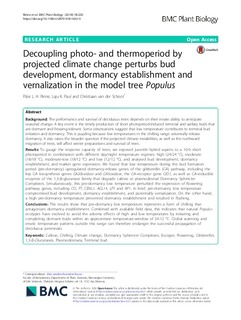| dc.contributor.author | Rinne, Paivi L.H. | |
| dc.contributor.author | Paul, Laju Kakkassery | |
| dc.contributor.author | van der Schoot, Christiaan | |
| dc.date.accessioned | 2018-11-13T11:41:28Z | |
| dc.date.available | 2018-11-13T11:41:28Z | |
| dc.date.created | 2018-10-07T13:07:30Z | |
| dc.date.issued | 2018 | |
| dc.identifier.citation | BMC Plant Biology. 2018, 18 (220), . | nb_NO |
| dc.identifier.issn | 1471-2229 | |
| dc.identifier.uri | http://hdl.handle.net/11250/2572206 | |
| dc.description.abstract | Abstract Background: The performance and survival of deciduous trees depends on their innate ability to anticipate seasonal change. A key event is the timely production of short photoperiod-induced terminal and axillary buds that are dormant and freezing-tolerant. Some observations suggest that low temperature contributes to terminal bud initiation and dormancy. This is puzzling because low temperatures in the chilling range universally release dormancy. It also raises the broader question if the projected climate instabilities, as well as the northward migration of trees, will affect winter preparations and survival of trees. Results: To gauge the response capacity of trees, we exposed juvenile hybrid aspens to a 10-h short photoperiod in combination with different day/night temperature regimes: high (24/24 °C), moderate (18/18 °C), moderate-low (18/12 °C) and low (12/12 °C), and analysed bud development, dormancy establishment, and marker gene expression. We found that low temperature during the bud formation period (pre-dormancy) upregulated dormancy-release genes of the gibberellin (GA) pathway, including the key GA biosynthesis genes GA20oxidase and GA3oxidase, the GA-receptor gene GID1, as well as GA-inducible enzymes of the 1,3-β-glucanase family that degrade callose at plasmodesmal Dormancy Sphincter Complexes. Simultaneously, this pre-dormancy low temperature perturbed the expression of flowering pathway genes, including CO, FT, CENL1, AGL14, LFY and AP1. In brief, pre-dormancy low temperature compromised bud development, dormancy establishment, and potentially vernalization. On the other hand, a high pre-dormancy temperature prevented dormancy establishment and resulted in flushing. Conclusions: The results show that pre-dormancy low temperature represents a form of chilling that antagonizes dormancy establishment. Combined with available field data, this indicates that natural Populus ecotypes have evolved to avoid the adverse effects of high and low temperatures by initiating and completing dormant buds within an approximate temperature-window of 24-12 °C. Global warming and erratic temperature patterns outside this range can therefore endanger the successful propagation of deciduous perennials. | |
| dc.language.iso | eng | nb_NO |
| dc.rights | Attribution-NonCommercial-NoDerivatives 4.0 Internasjonal | * |
| dc.rights.uri | http://creativecommons.org/licenses/by-nc-nd/4.0/deed.no | * |
| dc.title | Decoupling photo- and thermoperiod by projected climate change perturbs bud development, dormancy establishment and vernalization in the model tree Populus | nb_NO |
| dc.title.alternative | Decoupling photo- and thermoperiod by projected climate change perturbs bud development, dormancy establishment and vernalization in the model tree Populus | nb_NO |
| dc.type | Journal article | nb_NO |
| dc.type | Peer reviewed | nb_NO |
| dc.description.version | publishedVersion | |
| dc.source.pagenumber | 16 | nb_NO |
| dc.source.volume | 18 | nb_NO |
| dc.source.journal | BMC Plant Biology | nb_NO |
| dc.source.issue | 220 | nb_NO |
| dc.identifier.doi | 10.1186/s12870-018-1432-0 | |
| dc.identifier.cristin | 1618477 | |
| dc.relation.project | Norges forskningsråd: 263117 | nb_NO |
| cristin.unitcode | 192,10,2,0 | |
| cristin.unitname | Institutt for plantevitenskap | |
| cristin.ispublished | true | |
| cristin.fulltext | original | |
| cristin.qualitycode | 1 | |

